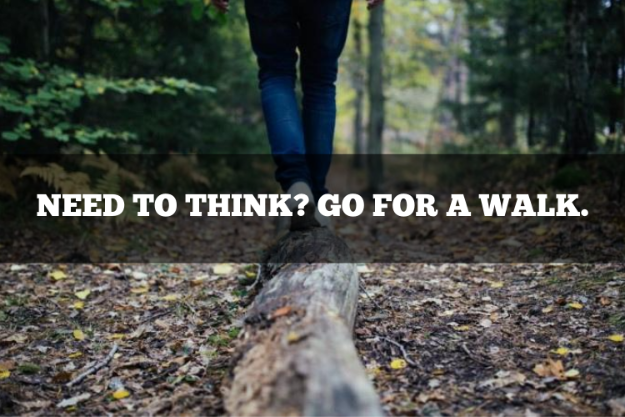
I don’t know about you, but I’ve been walking a lot more during the pandemic. Walking in the park, walking on the beach, walking to the store, just going for a walk with no particular destination in mind.
Setting aside the obvious cardiovascular benefits, walking has helped my mental clarity. In fact, if I’m stuck on a tough problem at work, want to think deeply or creatively, or just need to “clear my head,” a nice walk has done the trick.
This phenomenon really hit home the other day when I was reading Gary Rogowski’s book Handmade: Creative Focus in the Age of Distraction.
Not only is Gary a master craftsman in every sense of the word, he’s also a deep thinker and gifted writer. In his book, Gary muses on his many life experiences, including the benefits of walking.
Here’s a brief excerpt.
Thinking By Walking
I have no solid evidence. This is merely my hunch, my speculation. I came up with this theory while walking. Simply put, movement is important to thought.
The pace of walking is suited to our way of thinking. It is the rate at which we are supposed to be thinking. I believe we evolved as animals who climbed trees, who strode across the prairies, who walked from one camp to another, one fort to another, one city to the next until we learned to ride on animals, on one another, or on conveyances that were conceived by great and lazy minds on their walks.
Read Wendell Berry’s An Entrance to the Woods to understand the important of pace. “Our senses, after all, were developed to function at foot speeds; and the transition from foot travel to motor travel, in terms of evolutionary time, has been abrupt. The fast one goes, the more strain there is on the senses, the more they fail to take in, the more confusion they must tolerate or gloss over – and the longer it takes to bring the mind to a stop in the presence of anything.”
Walking is connected to thinking. This pace is one of meditation. It is the time for us to move ideas around as we move through a multitude of sensory stimuli. It is playtime. It is not considered remunerative so it is frowned upon. Yet daydreaming is not wasted time. It is enormously powerful, if scorned and misunderstood by logicians. Our brain is still mysterious ground for us even given our accumulation of knowledge. Consider your own dreams, if you can remember them from last night.
The pace of a walk helps call ideas forward unlike driving or riding a bicycle. I had a student who used his bicycle as his only form of transportation, In the worst weather he cycled, even if walking was safer or drier. On ice, in driving rain storms, he rode his bicycle so he could get There. Wherever “There” was, he wanted to get there faster. That’s one way of traveling. I know that something is missed by those cyclists, drivers, and commuters whose minds are set on getting there: wasted creative time.
Related: Tomorrow Never Comes (Take Action Today)
The meditation that can be walking allows my crowded thoughts to sift their way through my consciousness. They work themselves out in ways that are not logical or sensible. It is a place where synthesis must occur. This is creative right-brained activity and not logical left-brained work. This occurs in a locale where our mood and the colors and smells along the way, the shapes we see can all contribute to this synthesis and perhaps to an idea of merit. We walk and we dream, and then we put these dreams into action.
Walking acts as a curious stimulant to my brain. It opens me to a world of sights and smells and sounds that by its tempo, its rhythm, its curiosity finds fresh combinations and remembered patterns. I hear melodies or I play a song over and again in my head. I regain memories or bury them under new ones. being on a long walk is akin to attending the symphony. A friend of mine once told me, “It’s okay, listen to the music and just let your mind go wherever it wants to.” I use this same method when I walk. I try to have no conclusion to reach when I set out. This is simply an opportunity to let things sift. Like my beagle and his nose used to do, I let my mind take me wherever it may.
P.S. You can get Handmade: Creative Focus in the Age of Distraction on Amazon for less than $10 bucks. If you’re anything like me, it will be one of your best reads this year. Go snag a copy today and start walking more.
All the best,
JD